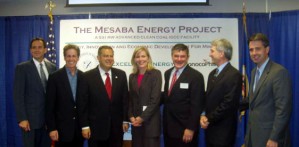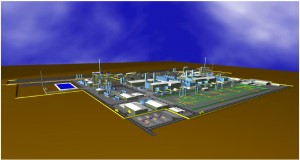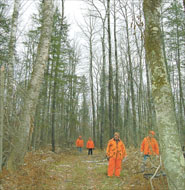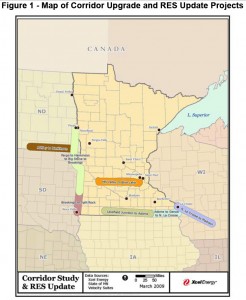Let Mesaba go…
December 19th, 2009
Jorgensen’s got to get over it — Mesaba is done, ain’t happening, dead, dead dead, yet she’s spinning those tales and hype about Excelsior Energy’s Mesaba IGCC Project. From the first words in the title, it’s lies, lies and more lies, oh, and misrepresentations and falsehoods and exaggerations and utter bullshit too! Why does the St. Paul Pioneer Press give her space forthis advertising of the nonsensical kind?
Here’s what Citizens Against the Mesaba Projet’s Charlotte Neigh had to say about it:
Julie Jorgensen is using the opportune hook of the Copenhagen conference to repeat Excelsior Energy’s same old, self-serving promotional claims about the “clean coal” technology of its Mesaba Energy Project. One must wonder why the Press unquestioningly allots opinion space to the promoter of a precarious for-profit venture, financed almost exclusively by $40 million in public funds, which have been benefiting the author and her co-founder husband, Tom Micheletti.
What Jorgensen didn’t say:
• The U.N. negotiators in Copenhagen decided to leave carbon capture and storage, the prime objective of the IGCC technology touted by Excelsior Energy, off the list of clean-energy projects eligible for the Clean Development Mechanism; the 12/17/09 Wall Street Journal reported that “clean coal seems to be getting the cold shoulder at the climate summit”, and “. . . clean coal is anything but viable right now”.
• Mesaba’s Unit I would emit 5 million tons of carbon dioxide per year and the Department of Energy has acknowledged that capturing and sequestering the CO2 from the proposed Taconite plant is not feasible.
• The claimed economic benefit has been rejected by the Minnesota Public Utilities Commission, which found the project too expensive and risky and not in the public interest.
• The need for this Project has never been proven; no utility is willing to buy its output; Xcel Energy successfully resisted efforts to force it into a power purchase agreement; and the MPUC has declined to require other utilities in the state to include Mesaba’s output in their resource plans.
• The environmental claims are yet to be adjudicated as the MPUC considers the route and siting permits and other government agencies pursue their concerns related to air, water and waste permits.
Is Jorgensen’s piece really that bad? See for yourself:
Julie Jorgensen: We need baseload power. Coal’s plentiful. Let’s clean it up
By Julie Jorgensen
Updated: 12/17/2009 05:54:25 PM CSTI’m the co-founder of Excelsior Energy, which is developing the Mesaba Energy Project, an IGCC power plant near the town of Taconite on Minnesota’s Iron Range. From my point of view, IGCC offers economic and environmental benefits to Minnesota. The Midwest is poised be a leader in the delivery of this technology. Gov. Tim Pawlenty and the Minnesota Legislature have supported the development of Minnesota’s IGCC plant, the Mesaba Energy Project, since 2003, and the project has been exempted from a statewide prohibition against new coal plants. Eleven Midwest governors established a collective goal to spur construction of at least five commercial-scale IGCC plants by 2015, and President Obama announced a goal to build five such “first-of-a-kind” clean coal plants. The U.S. Department of Energy (DOE) has provided significant funding and incentives to the Mesaba Project to offset the costs of needed innovation.
Adoption of IGCC technology is essential to cleaning up coal and mitigating climate change.
As fears mount about global warming, environmental advocates like the Clean Air Task Force and the Natural Resources Defense Council support the timely and widespread commercialization of IGCC technology. From a global perspective, the importance of commercializing a cleaner way to use coal cannot be understated: both India and China have vast coal reserves, which they will inevitably use in the cheapest and easiest possible ways to fuel their growing economies.
Additionally, the costs of new nuclear facilities may put them out of reach.
Julie Jorgensen is the former CEO of CogenAmerica, a publicly traded independent power company, and a former executive of NRG Energy, a global energy development company. She’s a co-founder of Excelsior Energy Inc., which is developing a coal gasification plant near Taconite on Minnesota’s Iron Range. Her e-mail address is JulieJorgensen@ExcelsiorEnergy.com.
Mesaba EIS? And close encounters of the Mesaba kind!
November 17th, 2009
The joint DOE and MN Dept. of Commerce EIS for Excelsior Energy’s Mesaba Project has been released. WTF? This is SUCH a waste of time. And I am at a lost to explain how it is that this even was released, why we have to bother with it, when it’s the vampire-vaporware project from hell that is dead but … but…
Excelsior Energy Mesaba Project Environmental Impact Statement
Comments on the “adequacy of the Final EIS or its impact upon the issues” are due on December 2, 2009. Send Comments to:
steve.mihalchick [at] oah.state.mn.us
or by mail to:
Steve Mihalchick, ALJ
Office of Administrative Hearings
P.O. Box 64620
St. Paul, MN 55164-0620
Here’s the Order establishing that deadline:
Is this weird language or what:
b. Such comments on the “adequacy” of the Final EIS or its “impact” upon the issues in this matter shall be filed with the Administrative Law Judge within ten business days after filing of the Final EIS.
So get cracking on “such comments” and send them in!
And just in, breaking news…
Just last Friday, a MCGPer and his son were out deer hunting on the preferred Excelsior site, guns in hand, on the alert, and what should come bursting through the trees but… BOB EVANS! Bob Evans and two other Excelsior boys, they were out viewing the site during deer hunting! That just doesn’t seem to bright.
Give it up!!! Get a job, Bob!!!
And have they forgotten that other encounter in the woods, almost exactly three years ago?
Meanwhile … the sun is coming up over New York right now…
WOW’s deal with the devil at issue
August 18th, 2009
“Wind on the Wires” and AWEA are whining and crying in the press about unfair treatment to wind generators. They do a deal with the devil to promote transmission and now are getting screwed — sorry, I won’t be hosting a pity party here!
AWEA and WOW’s FERC filing to protest MISO cost allocation proposal
To look at the full FERC docket, GO HERE TO FERC SEARCH PAGE, and search for docket ER09-1431.
“Wind on the Wires” is a subset of the Izaak Walton League – Midwest, not a separate organization. Some background here:
Years ago, the Midwest Izaak Walton League, together with MCEA, ME3 (Fresh Energy) and North American Water Office, did a deal with Xcel, and a massive “Wind on the Wires” grant was announced a couple of days later. The deal was to support a massive transmission buildout, specifically, to work to change state and federal law; to support transmission projects; to usher them through the legislature, state and federal administrative venues, to support at industry transmission planning groups; to support changes in rate recovery; to support changes in transmission need and siting criteria; and to allow transmission-only companies, all the things that Xcel wanted to roll out CapX 2020, JCSP, and whatever else is in their dreams.
Really… it’s all here:
$8.1 Million Wind on Wires grant from McKnight/Energy Foundation
This 2003 Settlement Agreement was in the Minnesota PUC’s TRANSLink docket, where Xcel wanted a transmission only company, not yet allowed in Minnesota. For the docket, go to www.puc.state.mn.us and then click on “eDockets” and search for docket 02-2152. F”or the resulting legislation, some of it, see 2005 Transmission Omnibus Bill from Hell.
So they jump through all those hoops and where are they? What happens?
Back to Cost Allocation of Transmission.
Let’s see… there was one cost allocation scheme, 50-50 split between owner utilities and generators connecting. Otter Tail Power objected and so the utilities changed it to a 90-10 split, and now “Wind on the Wires” and AWEA are screaming, whining and crying saying it has to go back. This has to do with how the utilities characterize the purpose of the line, be it for “Reliability” or “Generation Interconnection” and how costs are apportioned are different. In the CapX proceeding, the “Brookings line” was not declared, and the Fargo and LaCrosse lines were deemed “Reliability” but that’s absurd…
For “Baseline Reliability” projects here’s the cost allocation scheme:
For “Generation Interconnection” here’s the cost allocation scheme:
Ummmmm… a little more background here now that we’re talking about interconnection… does anyone remember the name of that coal plant that Otter Tail Power just got permitted to build? Oh, yeah, right, it’s BIG STONE II. And what was the name of that big honkin’ coal plant that “suddenly decided” to produce electricity rather than syngas? South Heart, yeah, that’s it. See “South Heart coal gasification — Coal on the Wires.” Both plants strategically placed to use CapX 2020 transmission. So what is the impact of this shift to Otter Tail Power and their Big Stone II project?
Here’s the Big Stone electrical link to CapX — it’s all connected:
Here’s new connector ND transmission announced April 3 — it’s all connected:
And of course, the big picture of CapX 2020 – click on it for a bigger picture to really appreciate those lines starting in the Dakotas:
Here’s an article from last week about their objections:
Wind industry protesting plan to pay for new lines
Cost-sharing proposal decried as threat to renewable energy goals
By Leslie Brooks Suzukamo
lsuzukamo@pioneerpress.com
Updated: 08/14/2009 12:01:26 PM CDT
So if “Wind on the Wires” and AWEA object to “generator pays” transmission, where it’s the generator causing the need, then they’re now in essence advocating for a different scheme for Big Stone II and South Heart coal plants too. Oh, good idea…
Here’s another one that turned up — WOW and AWEA sent out a raft of press releasees…
Wind Industry Fights Midwest Transmission Proposal to Stay Alive
by Stacy Feldman – Aug 17th, 2009
Even worse — the plan could put the nation’s renewable energy goals in jeopardy.
Currently, generators and utilities split the price paid, 50-50.
And then there’s the big issue of cost: Who would pay for it?
The MISO proposal is a local version of that long-simmering cost dispute.
FERC has not indicated whether it favors MISO’s proposal or would recommend changes.
South Heart coal gasification is alive ‘n’ kickin’
August 1st, 2009
The South Heart North Dakota coal gasification is now going to be an ELECTRIC GENERATION plant. DUH! The 800 pound gorilla has just started jumping around the room. This IGCC plant will be up and ready just in time to use CapX 2020 transmission — DUH! And if you’re surprised, you’re in the wrong business.
A change in plant plans
By: Jennifer McBride and Beth Wischmeyer, The Dickinson Press
The plant will be located four miles south and two miles west of South Heart and will be a
coal-to-hydrogen electrical generation plant.
The cost to build Great Northern’s plant is estimated at $1 billion.
Are we going to let them get away with this? I love it when my hunches are right, but I hate it when anyone has the audacity to propose something so utterly stupid as this. It will be hard for them to get it up and running… except who has a power plant application ready to rock (except that it’s a joke, but it takes some time to prove that to the PUC)? Drat… and here I thought Tom would be down in Honduras trying to build Mesaba down there…
Mesaba FEIS now delayed until JUNE!!!!
March 19th, 2009
Excelsior Energy’s Mesaba Project has been delayed… AGAIN… until June… and when we get closer to June, well, we know what will happen… delay again!
Thanks to Charlotte Neigh and CAMP for keeping on this!













